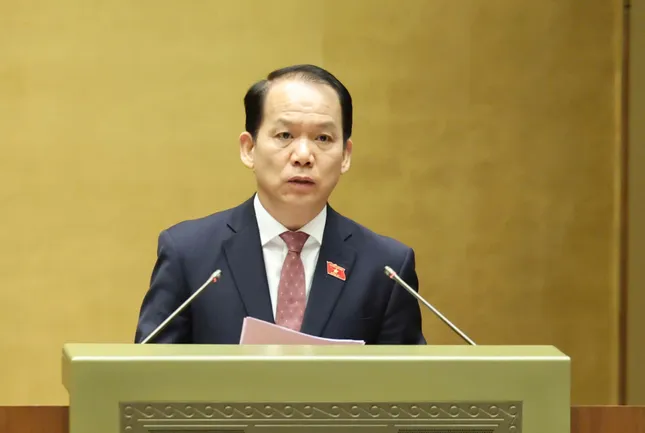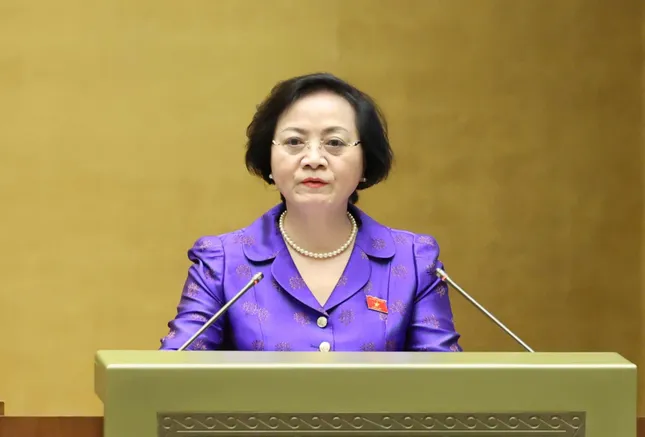The Minister of Home Affairs announced that based on the current status and development orientation of the 63 provinces and cities across the country, the government has proposed 23 arrangement plans for 52 administrative units at the provincial level to form 23 new provincial-level administrative units.
As a result of this reorganization, there will be 34 administrative units at the provincial level in Vietnam, consisting of 6 municipalities under the central government and 28 provinces. All 23 newly formed provincial-level units meet the standard criteria as outlined in the National Assembly’s Resolution.

Minister of Home Affairs Pham Thi Thanh Tra. Photo: Nhat Minh
Regarding the arrangement, streamlining, and personnel matters, according to a summary from local authorities, after reviewing and agreeing on the calculation method suggested by the Committee for Legal Affairs and Judiciary, the total number of officials, public employees, and civil servants based on the allocated quota for agencies, organizations, and provincial-level units in the 52 provinces and cities undergoing reorganization is 447,657 people (including 2,321 officials, 79,118 public employees, and 366,218 civil servants).
In terms of office space, the total number of provincial-level offices in the 52 provinces and cities is 38,182. Of these, 33,956 offices will continue to be used, leaving 4,226 surplus offices. The arrangement and utilization of offices, as well as the handling of finances and public assets after the reorganization of provincial-level administrative units, will be carried out in accordance with government regulations, directives from the Prime Minister, and guidance from the Ministry of Finance.
“Given the historical significance of the 9th session, the government requests the National Assembly to issue a general resolution for this session, recognizing and highly appreciating the important role and historic achievements of the district-level administrative units before their termination and the provincial-level and communal-level administrative units before the reorganization, for their continuous efforts in the development of the country and each locality,” said Minister Tra.
The Committee for Legal Affairs and Judiciary affirmed that the arrangement plans and names of the administrative units formed after the reorganization ensure alignment with the approved arrangement orientations and have received strong consensus from the people and the People’s Councils.

Chairman of the Committee for Legal Affairs and Judiciary, Hoang Thanh Tung. Photo: Nhat Minh
The newly formed units generally meet the standards in terms of natural area and population scale as stipulated.
Regarding the draft resolution of the National Assembly, the government proposes that the resolution take effect from July 1, 2025.
According to the agenda, the National Assembly will discuss the arrangement of provincial-level administrative units in a group meeting this afternoon (June 11) and then hold a plenary discussion and vote on it tomorrow morning (June 12).
The Committee for Legal Affairs and Judiciary proposed that the resolution take effect from the date of its adoption by the National Assembly on June 12. This will provide a legal basis for localities to carry out the handover process and make the necessary preparations to ensure that the local governments of the newly formed administrative units can promptly commence operations as planned by the Central Government (instead of July 1, 2025).
23 new provincial-level administrative units after the reorganization:
(1) Merging Ha Giang and Tuyen Quang provinces to form a new province named Tuyen Quang, with its political and administrative center located in the current province of Tuyen Quang.
(2) Merging Yen Bai and Lao Cai provinces to form a new province named Lao Cai, with its political and administrative center located in the current province of Yen Bai.
(3) Merging Bac Kan and Thai Nguyen provinces to form a new province, named Thai Nguyen, with its political and administrative center located in the current province of Thai Nguyen.
(4) Merging Vinh Phuc, Hoa Binh, and Phu Tho provinces to form a new province named Phu Tho, with its political and administrative center located in the current province of Phu Tho.
(5) Merging Bac Giang and Bac Ninh provinces to form a new province named Bac Ninh, with its political and administrative center located in the current province of Bac Giang.
(6) Merging Thai Binh and Hung Yen provinces to form a new province named Hung Yen, with its political and administrative center located in the current province of Hung Yen.
(7) Merging Hai Duong province and Hai Phong city to form a new city named Hai Phong, with its political and administrative center located in the current city of Hai Phong.
(8) Merging Ha Nam, Ninh Binh, and Nam Dinh provinces to form a new province named Ninh Binh, with its political and administrative center located in the current province of Ninh Binh.
(9) Merging Quang Binh and Quang Tri provinces to form a new province named Quang Tri, with its political and administrative center located in the current province of Quang Binh.
(10) Merging Quang Nam province and Da Nang city to form a new city named Da Nang, with its political and administrative center located in the current city of Da Nang.
(11) Merging Kon Tum and Quang Ngai provinces to form a new province named Quang Ngai, with its political and administrative center located in the current province of Quang Ngai.
(12) Merging Gia Lai and Binh Dinh provinces to form a new province named Gia Lai, with its political and administrative center located in the current province of Binh Dinh.
(13) Merging Ninh Thuan and Khanh Hoa provinces to form a new province named Khanh Hoa, with its political and administrative center located in the current province of Khanh Hoa.
(14) Merging Lam Dong, Dak Nong, and Binh Thuan provinces to form a new province named Lam Dong, with its political and administrative center located in the current province of Lam Dong.
(15) Merging Dak Lak and Phu Yen provinces to form a new province named Dak Lak, with its political and administrative center located in the current province of Dak Lak.
(16) Merging Ba Ria-Vung Tau, Binh Duong, and Ho Chi Minh City to form a new city named Ho Chi Minh City, with its political and administrative center located in the current Ho Chi Minh City.
(17) Merging Dong Nai and Binh Phuoc provinces to form a new province named Dong Nai, with its political and administrative center located in the current province of Dong Nai.
(18) Merging Tay Ninh and Long An provinces to form a new province named Tay Ninh, with its political and administrative center located in the current province of Long An.
(19) Merging Can Tho city, Soc Trang province, and Hau Giang province to form a new city named Can Tho, with its political and administrative center located in the current city of Can Tho.
(20) Merging Ben Tre, Vinh Long, and Tra Vinh provinces to form a new province named Vinh Long, with its political and administrative center located in the current province of Vinh Long.
(21) Merging Tien Giang and Dong Thap provinces to form a new province named Dong Thap, with its political and administrative center located in the current province of Tien Giang.
(22) Merging Bac Lieu and Ca Mau provinces to form a new province named Ca Mau, with its political and administrative center located in the current province of Ca Mau.
(23) Merging An Giang and Kien Giang provinces to form a new province named An Giang, with its political and administrative center located in the current province of Kien Giang.
The Great Administrative Reform: A Visionary Proposal for Provincial Consolidation
“The Minister of Finance and the Minister of Education and Training will be addressing the queries and concerns of the National Assembly delegates. Stay tuned for an insightful and informative session as these ministers shed light on pertinent issues and share their expertise and plans for the future.”
“A Streamlined Administrative System: Empowering Vietnam’s Progress”
With a unanimous approval rating, the National Assembly’s Standing Committee has passed in principle 34 resolutions on the rearrangement of communal-level administrative units for the year 2025. These resolutions, pertaining to 34 provinces and centrally-run cities post-merger, signify a pivotal step forward in administrative reform.














































